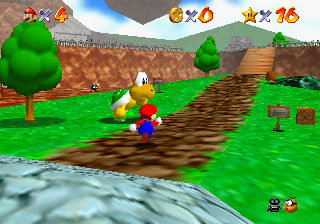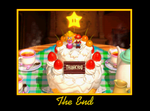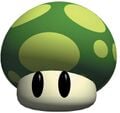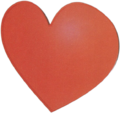Super Mario 64: Difference between revisions
m (→Abilities: .....) |
(we need the gallery.) |
||
| Line 1: | Line 1: | ||
{{FA}} | {{FA}} | ||
{{Infobox | {{Infobox | ||
|title=Super Mario 64 | |title=Super Mario 64 | ||
| Line 15: | Line 16: | ||
|input= | |input= | ||
}} | }} | ||
'''''Super Mario 64''''' is a 3-D platformer game for the [[Nintendo 64]]. It was first released in Japan on June 23, [[1996]]; in the U.S. on September 29, 1996; in Europe on March 1, [[1997]]; and in Australia on March 1, 1997. This game was one of two launch titles for the Nintendo 64, along with ''[[wikipedia:Pilotwings 64|Pilotwings 64]]'', which helped drive initial sales of the console. To date, it has sold over 11 million copies, and is the second most popular game on the [[Virtual Console]]. It is the first game in the ''[[Mario (series)|Super Mario]]'' 3D series. | '''''Super Mario 64''''' is a 3-D platformer game for the [[Nintendo 64]]. It was first released in Japan on June 23, [[1996]]; in the U.S. on September 29, 1996; in Europe on March 1, [[1997]]; and in Australia on March 1, 1997. This game was one of two launch titles for the Nintendo 64, along with ''[[wikipedia:Pilotwings 64|Pilotwings 64]]'', which helped drive initial sales of the console. To date, it has sold over 11 million copies, and is the second most popular game on the [[Virtual Console]]. It is the first game in the ''[[Mario (series)|Super Mario]]'' 3D series. | ||
| Line 66: | Line 68: | ||
In addition to Mario's signature [[Jump|jumping]], a whole new host of abilities is given to the player as the game progresses. Mario can punch, kick, kick jump, hip drop ([[Yoshi]] and [[Wario]] could do this previously), triple jump, long jump, back flip, somersault, and perform the wall kick (bouncing from wall to wall with timed jumps to reach higher areas). The usual [[Super Mushroom]] and [[Fire Flower]] are absent in this game. Instead Mario gains the power to wear new hats, in the form of colored Caps. The [[Power Gauge]] is also introduced, which became standard for future Mario games. | In addition to Mario's signature [[Jump|jumping]], a whole new host of abilities is given to the player as the game progresses. Mario can punch, kick, kick jump, hip drop ([[Yoshi]] and [[Wario]] could do this previously), triple jump, long jump, back flip, somersault, and perform the wall kick (bouncing from wall to wall with timed jumps to reach higher areas). The usual [[Super Mushroom]] and [[Fire Flower]] are absent in this game. Instead Mario gains the power to wear new hats, in the form of colored Caps. The [[Power Gauge]] is also introduced, which became standard for future Mario games. | ||
The Caps are found inside special '!' blocks littered around the every level. Initially empty, they can be filled by finding '!' switches (similar to the [[Switch Palace]]s of ''[[Super Mario World]]''). There are three colors to the caps, and each cap lets Mario perform different abilities | The Caps are found inside special '!' blocks littered around the every level. Initially empty, they can be filled by finding '!' switches (similar to the [[Switch Palace]]s of ''[[Super Mario World]]''). There are three colors to the caps, and each cap lets Mario perform different abilities it should also be noted that only one form of colored cap can be found in each level. in each level Normally, each cap is worn separately, but Mario can sometimes don two caps at once and combine the abilities of both. | ||
*The [[Wing Cap]] (red) allows Mario to transform into [[Wing Mario]] and fly around if he performs a triple jump or blasts out of a cannon. This is useful for reaching high or far areas, and finding secrets in the sky. | *The [[Wing Cap]] (red) allows Mario to transform into [[Wing Mario]] and fly around if he performs a triple jump or blasts out of a cannon. This is useful for reaching high or far areas, and finding secrets in the sky. | ||
| Line 78: | Line 80: | ||
*[[Amp]]s | *[[Amp]]s | ||
*[[Bill Blaster]]s | *[[Bill Blaster]]s | ||
*[[Bob-omb]]s | *[[Bob-omb]]s | ||
*[[Bully|Bullies]] | *[[Bully|Bullies]] | ||
*[[Boo]]s | *[[Boo]]s | ||
*[[Bookend]]s | *[[Bookend]]s | ||
*[[Bub (species)|Bub]]s | *[[Bub (species)|Bub]]s | ||
*[[Bubba]]s | *[[Bubba]]s | ||
*[[Bullet Bill]]s | *[[Bullet Bill]]s | ||
*[[Chuckya]]s | |||
*[[Chuckya]]s | |||
*[[Fire Shooter]]s | *[[Fire Shooter]]s | ||
*[[Fire Spitter]]s | *[[Fire Spitter]]s | ||
*[[Fly Guy]]s | *[[Fly Guy]]s | ||
*[[Fwoosh|Fwooshes]] | *[[Fwoosh|Fwooshes]] | ||
*[[Goomba]]s | *[[Goomba]]s | ||
*[[Grand Goomba]]s | |||
| | | | ||
*[[Grindel]]s | *[[Grindel]]s | ||
*[[Heave Ho]]s | *[[Heave Ho]]s | ||
*[[Killer Chair]]s | *[[Killer Chair]]s | ||
*[[Klepto]] | *[[Klepto]] | ||
*[[Koopa Troopa]]s | *[[Koopa Troopa]]s | ||
*[[Lakitu]]s | *[[Lakitu]]s | ||
*[[Mad Piano]] | *[[Mad Piano]] | ||
*[[Micro-Goomba]]s | *[[Micro-Goomba]]s | ||
*[[Moneybag]]s | *[[Moneybag]]s | ||
*[[Monty Mole]]s | *[[Monty Mole]]s | ||
*[[Mr. Blizzard]]s | *[[Mr. Blizzard]]s | ||
*[[Mr. I]]s | *[[Mr. I]]s | ||
*[[Piranha Plant]]s | *[[Piranha Plant]]s | ||
*[[Pokey]]s | *[[Pokey]]s | ||
*[[Pushy Wall]]s | *[[Pushy Wall]]s | ||
*[[Scuttle Bug]]s | |||
| | | | ||
*[[Skeeter]]s | |||
*[[Skeeter]]s | *[[Snufit]]s | ||
*[[Snufit]]s | *[[Spindel]]s | ||
*[[Spindel]]s | *[[Spindrift]]s | ||
*[[Spindrift]]s | *[[Spiny|Spinies]] | ||
*[[Spiny|Spinies]] | *[[Sushi]]s | ||
*[[Sushi]]s | |||
*[[Swooper]]s | *[[Swooper]]s | ||
*[[Thwomp]]s | *[[Thwomp]]s | ||
*[[Tox Box]]es | *[[Tox Box]]es | ||
*[[Tweester]]s | *[[Tweester]]s | ||
*[[Ukiki]] | *[[Ukiki]] | ||
*[[Unagi]] | *[[Unagi]] | ||
*[[Venus Fire Trap]]s | *[[Venus Fire Trap]]s | ||
*[[Whomp]]s | *[[Whomp]]s | ||
*[[chain chomp]] | |||
==Bosses== | ==Bosses== | ||
| Line 131: | Line 132: | ||
*[[Big Bob-omb]] – A giant Bob-omb in [[Bob-omb Battlefield]]. He appears as the first star. | *[[Big Bob-omb]] – A giant Bob-omb in [[Bob-omb Battlefield]]. He appears as the first star. | ||
*[[Whomp King]] – A giant Whomp on top of [[Whomp's Fortress]]. He appears as the first star, and after he is defeated, there is a tower on top of the fortress. | *[[Whomp King]] – A giant Whomp on top of [[Whomp's Fortress]]. He appears as the first star, and after he is defeated, there is a tower on top of the fortress. | ||
*[[Bowser in the Dark World]] – Bowser appears at the end of this level. The player needs to swing him by the tail clockwise or counterclockwise and hurl him at bombs on the outside of his circular arena. | *[[Bowser in the Dark World]] – Bowser appears at the end of this level. The player needs to swing him by the tail clockwise or counterclockwise and hurl him at bombs on the outside of his circular arena. | ||
| Line 168: | Line 170: | ||
*''[[Super Mario Sunshine]]'' - A brief clip of Mario's fight with Bowser is seen when [[FLUDD]] scans Mario. | *''[[Super Mario Sunshine]]'' - A brief clip of Mario's fight with Bowser is seen when [[FLUDD]] scans Mario. | ||
*''[[Super Mario Galaxy 2]]'' - In [[Tall Trunk Galaxy]], [[The Princess's Secret Slide]] music plays at a moment. Also, the [[Whomp's Fortress]] reappears as the [[Throwback Galaxy]], alongside [[Bob-omb Buddy|Bob-Omb Buddies]] and the [[Whomp King]]. Both games start with Peach sending a letter to Mario. | *''[[Super Mario Galaxy 2]]'' - In [[Tall Trunk Galaxy]], [[The Princess's Secret Slide]] music plays at a moment. Also, the [[Whomp's Fortress]] reappears as the [[Throwback Galaxy]], alongside [[Bob-omb Buddy|Bob-Omb Buddies]] and the [[Whomp King]]. Both games start with Peach sending a letter to Mario. | ||
[[new super mario bros wii]] peaches castle reapears in this game as well as the music inside is also probaly a remix of this games music | |||
==Official Artwork== | |||
{{morepic}} | |||
It should be noted that because of the artwork's age and distribution, the color quality of the original ''Super Mario 64'' artwork vary widely. | |||
===Mario=== | |||
<center><gallery> | |||
Image:Mario64victory.gif|<center>Mario's classic pose | |||
Image:Sm64 mariofly.gif|<center>Mario with the [[Wing Cap]] | |||
Image:Normal mariobobomblarge.jpeg|<center>Mario carrying a [[Bob-omb]] | |||
Image:Mariobowser.jpeg|<center>Mario swinging Bowser | |||
Image:Marioheadslide.jpg|<center>Mario sliding on his stomach | |||
Image:Mario64sleeping.gif|<center>Mario sleeping | |||
Image:SM64MetalMario.jpg|<center>[[Metal Mario]] | |||
</gallery></center> | |||
===Other Characters=== | |||
<center><gallery> | |||
Image:Princess Peach Super Mario 64.png|<center>[[Princess Peach]] | |||
Image:Bowsersm64.gif|<center>[[Bowser]] | |||
Image:Bowserfirebreath.png|<center>Mario and Bowser fighting | |||
Image:Penguin.jpg|<center>Mama Penguin and her baby, Tuxie | |||
</gallery></center> | |||
===Boxarts=== | |||
<center><gallery> | |||
Image:Box sm64 j.gif|<center>Japanese version | |||
Image:Box sm64 j rpak.jpg|<center>Japanese version (Rumble Pak) | |||
Image:Box sm64 pcms.jpg|<center>US version (Player's Choice) | |||
Image:Box sm64 pal.jpg|<center>European version | |||
</gallery></center> | |||
== | ===Items=== | ||
<center><gallery> | |||
Image:1upMushroom_SM64.jpg|<center>[[1-up Mushroom]] | |||
Image:Wingcapblock.jpg|<center>[[Wing Cap]] Block | |||
Image:SM64SpinningHeart.png|<center>[[Spinning Heart]] | |||
</gallery></center> | |||
==Beta elements== | ==Beta elements== | ||
{{main|Super Mario 64/Beta elements}} | {{main|Super Mario 64/Beta elements}} | ||
==Glitches== | ==Glitches== | ||
{{main|Super Mario 64/Glitches}} | {{main|Super Mario 64/Glitches}} | ||
==Staff== | ==Staff== | ||
{{main|Super Mario 64/Staff}} | {{main|Super Mario 64/Staff}} | ||
Revision as of 13:00, June 27, 2010
Super Mario 64 is a 3-D platformer game for the Nintendo 64. It was first released in Japan on June 23, 1996; in the U.S. on September 29, 1996; in Europe on March 1, 1997; and in Australia on March 1, 1997. This game was one of two launch titles for the Nintendo 64, along with Pilotwings 64, which helped drive initial sales of the console. To date, it has sold over 11 million copies, and is the second most popular game on the Virtual Console. It is the first game in the Super Mario 3D series.
Super Mario 64 was originally in development for the Super Famicom, or SNES outside of Japan, but was moved to the Nintendo 64 after limitations proved very hassling[1]. Though it was not the first 3-D platforming game, it revolutionized the genre, with many games soon following its formula using it as a sort of benchmark[2]. It is widely acclaimed as one of the greatest games of all time[3][4][5].
A version of the game was released in Japan on July 18, 1997, that included Rumble Pak support. This is actually the same as the International release of the game, as it retains all of the glitch fixes as well as graphical and sound changes (except Mario calling Bowser by his name in a voice clip, which was "buh-bye" in all Japanese versions as he tosses him by the tail - this is because he is not known as Bowser in Japan). The only differences other than one voice clip are the language being changed back to Japanese and the Rumble Pak support.
A remake of Super Mario 64 was released for the Nintendo DS entitled Super Mario 64 DS in 2004. The remake had various differences from the original game. There was also a sequel planned called Super Mario 64 2, though it was canceled.
Storyline
Princess Peach sent a letter to Mario to come and have some cake with her in the castle. When he arrives, he finds one of the Lakitu Bros. who follows him around dangling a camera. Together, they go inside and hear a familiar voice telling them to get out of the castle. Toad informs them that Bowser has kidnapped the princess again and is holding everyone hostage inside the castle walls. He has also stolen the Power Stars and given them to his minions who are hiding in paintings. Mario hops in the magical paintings and retrieves the Power Stars in order to defeat Bowser and save the Princess.
After a long journey, Mario counts his stars and discovers he has enough of them to go into Bowser's final maze, and goes through another one of the Koopa King's obstacle courses. Once getting through, Mario finds Bowser waiting for him. The two engage in battle. Bowser ends up defeated, and is surprised when Mario tells him there were some power stars he missed. Bowser gives up, and hands Mario the final Giant Power Star before he explodes. When Mario grabs the last power star, wings appear on his cap, allowing him to fly. He circles the star-shaped arena, and flies away. Eventually, he lands in front of the castle.
As his wings fade away, Mario uses the power of the Giant Power Star, to make Princess Peach appear in front of the castle. The star goes into the glass painting, the painting flashes, and Peach slowly descends to the ground. Mario rushes up to her as she wakes up. Thanking him, Peach kisses Mario and says she will make a cake for him. Peach and two nearby Mushroom Retainers walk into the castle. Mario starts to do so himself, but then pauses and turns around to look at the sky, and watch the birds flying. Peach calls his name and Mario runs in after her and the Mushroom Retainers. After the credits scroll, the cake, with Peach and Mario figures, is shown at the very end.
Courses

Levels are laid out inside paintings in the castle, or sometimes the walls themselves. They can also be found in holes, gaps, oil pits, and inside a clock. Each world has 7 Power Stars. Within each, one of which is gained by finding 100 coins in the level. The other six Stars are found by performing "missions", fighting bosses, winning races, and etc. Every course has boundaries to limit the player from going too far, either as a strict wall or an invisible boundary. If Mario hits either, he falls down (quite often to his death). Otherwise, Mario is free to roam the large expansive levels at his leisure.
Levels often feature pink Bob-ombs called Bob-omb Buddies. They open cannons littered around the levels for Mario to fly with. When the cannon is open, Mario simply falls into the pit where it is, and it raises. The player targets the cannon with a cross hair shot, and fires. This helps Mario reach high or far away areas. It is often a good idea to use the Wing Cap (see below) with cannons.
- Bob-omb Battlefield
- Whomp's Fortress
- Jolly Roger Bay
- Cool, Cool Mountain
- Big Boo's Haunt
- Hazy Maze Cave
- Lethal Lava Land
- Shifting Sand Land
- Dire, Dire Docks
- Snowman's Land
- Wet-Dry World
- Tall Tall Mountain
- Tiny-Huge Island
- Tick Tock Clock
- Rainbow Ride
Secret Courses
In addition to the main courses of the game and the Bowser Courses, there are also a few hidden courses that house several of the Castle's Secret Stars, as well as the three ! Switches.
- The Princess's Secret Slide
- The Secret Aquarium
- Tower of the Wing Cap
- Vanish Cap Under the Moat
- Cavern of the Metal Cap
- Wing Mario Over the Rainbow
Abilities
In addition to Mario's signature jumping, a whole new host of abilities is given to the player as the game progresses. Mario can punch, kick, kick jump, hip drop (Yoshi and Wario could do this previously), triple jump, long jump, back flip, somersault, and perform the wall kick (bouncing from wall to wall with timed jumps to reach higher areas). The usual Super Mushroom and Fire Flower are absent in this game. Instead Mario gains the power to wear new hats, in the form of colored Caps. The Power Gauge is also introduced, which became standard for future Mario games.
The Caps are found inside special '!' blocks littered around the every level. Initially empty, they can be filled by finding '!' switches (similar to the Switch Palaces of Super Mario World). There are three colors to the caps, and each cap lets Mario perform different abilities it should also be noted that only one form of colored cap can be found in each level. in each level Normally, each cap is worn separately, but Mario can sometimes don two caps at once and combine the abilities of both.
- The Wing Cap (red) allows Mario to transform into Wing Mario and fly around if he performs a triple jump or blasts out of a cannon. This is useful for reaching high or far areas, and finding secrets in the sky.
- The Vanish Cap (blue) makes Mario transform into Vanish Mario which makes him invulnerable to attacks. He can also walk through some walls to reach new areas, where he can find hidden items or Power Stars. Also, all enemies' attacks travel through him.
- The Metal Cap (green) Mario to transform into Metal Mario which makes him metallic and heavy. This lets Mario defeat enemies by walking into them, walk through streams of fire without taking damage, avoid water currents, and walk under water.
Enemies
BossesThere are various mini bosses in some stages, but the primary boss is Bowser. He appears three times in three different levels. This is a list of the bosses in the game.
Notable Mistakes and Errors
References to Other Games
References in Later Games
new super mario bros wii peaches castle reapears in this game as well as the music inside is also probaly a remix of this games music Official ArtworkTemplate:Morepic It should be noted that because of the artwork's age and distribution, the color quality of the original Super Mario 64 artwork vary widely. MarioOther Characters
Boxarts
Items
Beta elements
Glitches
Staff
Trivia
File:Sm64easteregg.jpg The flying fish Easter egg.
ReferencesExternal links
|
||||||||||||||||


